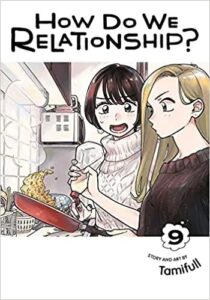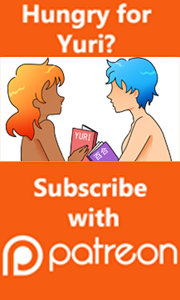 Matt Marcus is a cohost of various projects on the Pitch Drop Podcast Network, as well as the writer for the blog Oh My God, They Were Bandmates analyzing How Do We Relationship in greater depth.
Matt Marcus is a cohost of various projects on the Pitch Drop Podcast Network, as well as the writer for the blog Oh My God, They Were Bandmates analyzing How Do We Relationship in greater depth.
Last volume, Miwa finally got a new girlfriend, the surly but earnest Tamaki. Meanwhile, Saeko and Yuria are getting along well, their struggles with sex notwithstanding. Now our two leads begin the delicate dance of finding the right distance between them to be respectful to their girlfriends. Oh, and they agree to not let their partners know that they are each other’s ex. Or even that their best friend is also gay.
Really, How Do We Relationship Volume 9 is a Saeko-centric volume, and she really goes through it. She runs into a middle school classmate who cajoles her to go to her Coming of Age Ceremony, which is already a major point of friction between her and her mother. What’s worse is she witnesses Tamaki’s supposedly supportive friends engage in some Light Homophobia. Yuria does what she can to soothe her but she can’t be around all the time, so Saeko is left on her own, wallowing in her rising anger.
I have to continue to hand it to Tamifull that there is some really deft storytelling happening here. All three incidents that Saeko runs into here involve people who are generally good, well-meaning people, but there is just a strain of shittiness to them that is too stark to ignore. Her old classmate sympathizes with her choice to not attend the ceremony because of how hard her experience must have been…but still he takes one look over to Yuria and can’t help but comment “I guess you still swing that way, huh?” Tamaki’s friends are all vocally supportive to her face, but when The Gays aren’t around they say condescending things like, “they could have relationships with men if they want” and “oh, actually it’s noble of them to choose love over society’s acceptance”. Saeko’s mother, as we learned, doesn’t care who she dates so long as she acts a bit more feminine for her sometimes. It sucks. These aren’t people who are so wholly terrible that it would be an easy choice for Saeko to cut them out of her life, but their low-level hostility towards her identity understandably puts her on a hair trigger.
If this were earlier in the series, things would continue to devolve. Instead, a small miracle happens: Saeko runs into Miwa who invites her over for lunch. Miwa admits that its too hard for her to try to keep away from someone she truly cares for, and this gives Saeko the push to finally, finally tell Miwa about middle school. Afterwards, they have a cute snowball fight that is also a “I’m going to caringly tell you why you suck” back-and-forth. Saeko realizes that her fixation on staying away was the wrong idea, that Miwa is a special person to her, just not in the same way that Yuria is.
You know, I tend to shortchange Yuria in these reviews but she really is the MVP of the series so far. Every time Saeko has been struggling with something, she’s always had the right answer. She’s almost too self-actualized. Saeko awkwardly tries to rise to her level of Good Partnering, and there’s something really endearing about that, but none of it would feel right if Yuria wasn’t there. I also realized after the last review that she does share traits with Miwa (mostly romantic inexperience and naivete) in a similar way that I called out between Tamaki and Saeko. So, both girls ended up dating people who echo their ex’s personality, but not to the point of being overt duplications. It’s fantastic, subtle character work.
…That said, I have to give one demerit. Saeko and Yuria have a bit of a breakthrough in their sex life, and while the moment is meant to be a moment of vulnerability finally achieved, the way it articulates does feel a little hinky on consent. Having seen similar moments in other series, I want to chalk this up to cultural differences in the way women are “expected” to express themselves during sex in Japan, but I am frankly not the person to make that judgment. You could make a character argument for the way it is on the page but I feel like the same point would have been made stronger if the dialogue was tweaked to be more clear on consent. I may be making a mountain out of a molehill on this, but my honest reaction was to be a bit disappointed that in a series that generally avoids tropes, this one made it in and slightly soured an otherwise sweet scene.
Meanwhile, Miwa and Tamaki are getting along fine, though–stop me if you heard this before–they are not gelling sexually (“and so…they were both bassists”). It isn’t an intractable problem, but Miwa’s needs are going to be challenged, both because she needs to actually ask for them and also because Tamaki passed the entrance exam for her first choice college and is going to transfer. Aside from the two-faced nature of how Tamaki’s friends talk to her and about her relationship, this volume doesn’t focus on these two all that much.
We do get a chapter from the perspective of Saeko’s mom, and as a recent parent myself (of a little girl, no less), I found it really moving. Being a parent is hard. Things won’t play out like you always imagined they would, and it takes some fortitude to roll with those punches. As I said above, Mrs. Sawatari has got her heart in the right place and is doing her best, despite the friction she causes about Saeko’s lack of femininity. You feel for her, which is a hell of a thing to pull off with a character whose full name we still don’t know.
From a macro-plot perspective, we can still see tendrils of attachment that still entangle our leads: Saeko still has some lingering romantic feelings while Miwa just cannot forget how good the sex was. Now, if we are to believe the end-of-volume “commentary tracks” [SIGH], these would be the avenues that will lead the girls to get back together in the future. I don’t like the idea, frankly. I prefer them as close intimate friends, but the seeds are clearly there for them to get back together down the road.
Regardless, the thrust of this volume is how the girls managed to bridge the awkward distance between them and it’s super satisfying. The scene that’s depicted on the cover of the girls improvising their way through cooking fried rice together and ending up with a fantastic dish that they couldn’t replicate if they tried is a perfect metaphor for their current relationship: it’s some great fucking food.
Art – 9 The art is in its groove, though I’m starting to notice a habit of flipping which sides two characters are on back and forth in some scenes.
Story – 9 The one demerit aside, the story continues to be compelling and satisfying
Characters – 10 The nuance of the characters, even in the secondary cast, continues to impress
Service – 5 The sex is more sensual and plot driving than “servicey” per se, but I’m keeping the score up
Yuri – 10 / LGBTQ – 10 Bumping this up for the non-romantic yuri and the crushingly realistic depiction of bad allyship
Overall – 9 A delicious dish, best served with your closest friend
If you didn’t know already, the series is now being localized and released alongside the biweekly Japanese serialization on the new(ish) VIZ app. Unfortunately, there is an 11 chapter gap in English between the end of this volume and when the simulpub chapters began, and if RightStuf is to be believed, volume 10 won’t come out until late January. Just imagine me sweating profusely every time I see a new chapter up.
![]()


